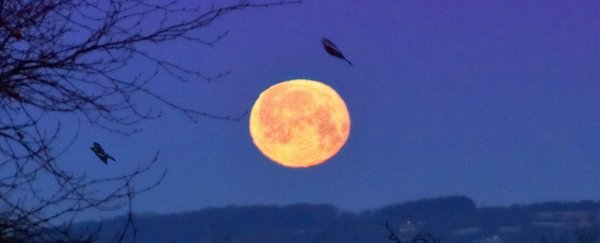For everyone in the Northern Hemisphere, this Monday marks the summer solstice, the longest day of the year.
And if that's not enough of a reason to head outside and look up, for the first time in almost 50 years, the event will also fall on the same day as a full 'strawberry moon' - two events that only coincide roughly once in a generation.
On its own, a strawberry moon isn't that rare - it's the name given to any full moon occurring in June, and was named by indigenous Americans as it signalled the beginning of strawberry season. The June full moon has also been called the 'honey moon' because the summer month is so popular with Northern Hemisphere weddings.
The solstice also occurs twice a year - once in winter, once in summer - when the tilt of the Earth's axis stops the Sun from shifting north in our sky and begins to head south again.
But what is rare is for the strawberry moon to fall exactly on the summer solstice in the Northern Hemisphere.
Using Universal Time (UTC), or Greenwich Mean Time - which astronomers prefer, as it applies to Earth as a whole - the last time the two events coincided was in 1967, ushering in the famous 'summer of love'. And the next time we'll witness it will be 21 June 2062.
So for many of us, this might be the only chance of us to see the two astronomical events line up in our lifetime.
To celebrate, online observatory Slooh will be hosting a live stream of the strawberry moon from its Canary Islands observatory.
It's not just a coincidence of timing that's special about this Moon though - the Moon will also take on a rich, golden shade for most of the night, because of its position in relation to the Sun.
"By landing exactly on the solstice, this full moon doesn't just rise as the Sun sets but is opposite the Sun in all other ways too," writes Farmer's Almanac columnist Bob Berman, who's co-hosting the Slooh live stream.
This means the full moon is going to be low in the sky, so our atmosphere is going to scatter the light bouncing off it. The effect is that mostly yellow, orange, and red light will reach our eyes, giving the Moon a rich, golden hue. This is the same effect that causes sunsets.
For those of us in the Southern Hemisphere, we'll still get to enjoy a full moon with our winter solstice, but the Moon will be high up in our sky. And, even better, it's all uphill from the shortest day of the year.
No matter where you are in the world, or what the weather's like outside, you can enjoy the live stream of the rare solstice strawberry moon below:
